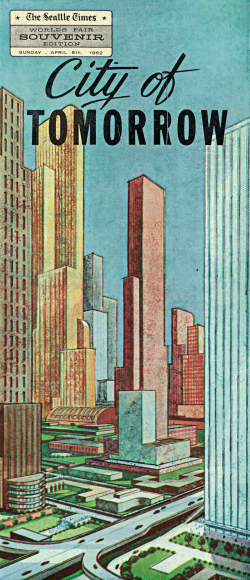Last Friday the Seattle Times posted their entire 1962 World’s Fair souvenir edition paper in pdf format. I had some time this weekend to look through it, and there are quite a few amusing and interesting real-estate-related gems to be found in this 50-year time capsule…
On Realtor marketing tactics, page 4 (4-C):
Realtor’s Gift Ties Boost World’s Fair
One of the more original boosters of the fair is R.C. Schiefelbein, Edmonds Realtor, who took 20 dozen neckties to a Chicago real-estate convention.Each necktie had a picture of the Space Needle and underneath, “Ask a Realtor.”
 Pretty sure if you tried a stunt like that today, the Space Needle corporation would sue you for trademark infringement.
Pretty sure if you tried a stunt like that today, the Space Needle corporation would sue you for trademark infringement.
An ad on page 14 (14-C) declares:
PLENTY OF MONEY FOR HOME LOANS
Conventional bank loans—Up to 75% appraisal and up to 25 years.
Interesting that 50 years ago borrowers using conventional financing had to bring 25% down and could only get a 25-year mortgage. I wonder how many of today’s home buyers could afford to buy a home around Seattle under those terms.
On architecture, page 58 (10-E):
“I hope that urban housing problems can be better solved by more ingenious planning such as row houses, court plans, and the like rather than the conventional street pattern of individual lots,” Bumgardner said.
Imaginative design can provide imaginative individuality in such scenes he said.
I wish. Instead of imaginative design, we got row after row of ugly townhomes.
On swimming pools, page 67 (E-19):
There is one thing on which all executives of companies that make swimming pools agree, and that is that home-owners of the future will insist on having at least one pool included with the facilities of their home.
Real-estate salesmen showing a prospective customer through a home will point out the fact that it has two pools, much as today they remark on two baths.
“At present,” William M. Smith of Pacific Pools said, “there are less than 10,000 private swimming pools in Greater Seattle. At the rate they are increasing I predict we will have 30,000 in about ten years.
…
These extras that we consider luxuries will be quite common in the 21st Century and will cost very little.
I don’t recall my real estate agent pointing out two pools in a home even once while I was home-shopping. I got ripped off.
On Lake Hills, page 98 (2-H):
Lake Hills, a community that began only six years ago on hilltops between Bellevue and Lake Sammamish, is the kind of community that pessimists had described as impossible to accomplish.
Larger than any other planned Seattle-area community, it typifies the foresight of many builders and developers.
R. H. Conners, the developer, bought 1,200 acres in 1945. He has added 300 acres since. George Belle has constructed most of the 4,000 homes. Bell expects to build 12,000 more homes over the next ten years.
…
The prices range from $15,000 to $45,000.
$45,000 in 1962 is roughly equivalent to $342,000 in 2012 dollars. I bet there are a few people who wish they could buy one of the nicest homes in Lake Hills for $342,000.
Hit the jump for a few more gems that I found amusing but don’t particularly relate to real estate.
On sports arenas, page 12 (12-C):
Construction of the Washington State Coliseum — the first new major structure for the World’s Fair — was under way.
…the Coliseum — spreading out over almost four acres like a massive metal “big top” — has become one of the top architectural attractions on the fairgrounds.
…
“Paul’s Paraboloid,” sports fans call it in fond jest, as they wait impatiently for the day when it will be theirs.
For those who aren’t aware, the Coliseum was the original name for the Key Arena.
On public transit, page 20 (20-C):
The Seattle World’s Fair has a magic carpet.
The name is Monorail.
Zooming along at ta mile-a-minute speed, two Monorail trains will whisk passengers from downtown Seattle to the fairgrounds and return.
Fair officials are predicting the Monorail will be the exposition’s “main gate,” carrying perhaps 40 per cent of the paying customers.
This is the world’s first full-scale rapid-transit system — both an attraction for the fair and perhaps a preview of the transportation of the future.
…
Sixten Holmquist, Alweg’s president, is optimistic about the Monorail’s future as a rapid-transit system.“This is the spark that could touch off a revolution in transportation,” Holmquist said.
Fifty years later, every major metropolitan city relies on Monorails to whisk commuters from their homes to work and return. Er, wait a minute…
On local transportation infrastructure, page 132 (J-3):
…the King-Pierce-Snohomish-Kitsap area…must be prepared to accommodate 3,000,000 residents by 1990, if not sooner.
Transportation will be one problem. An air-view of the Seattle area shows how the freeway now being built will provide a further linking of Seattle, Tacoma and Everett and how the Evergreen Point Floating Bridge will double the development opportunities east of Lake Washington.
These facilities, however, will fall far short of meeting all needs of the 3,000,000 persons who must have opportunities to move from home to work and to recreation areas.
The freeway they’re talking about is I-5. Aside from the construction of a second I-90 span across Lake Washington, very little major transportation infrastructure seems to have been built since this was written fifty years ago. With approximately 3.7 million people living in the four-county region as of 2011, I think most would agree with the assessment that our existing transportation options do indeed “fall far short of meeting all needs.” Whoops!
